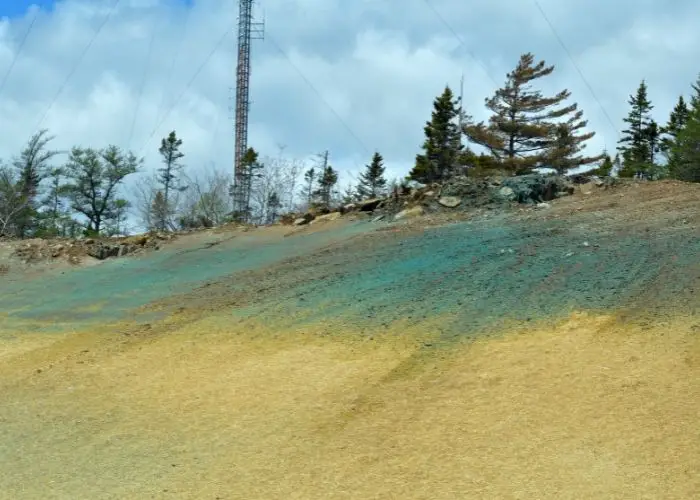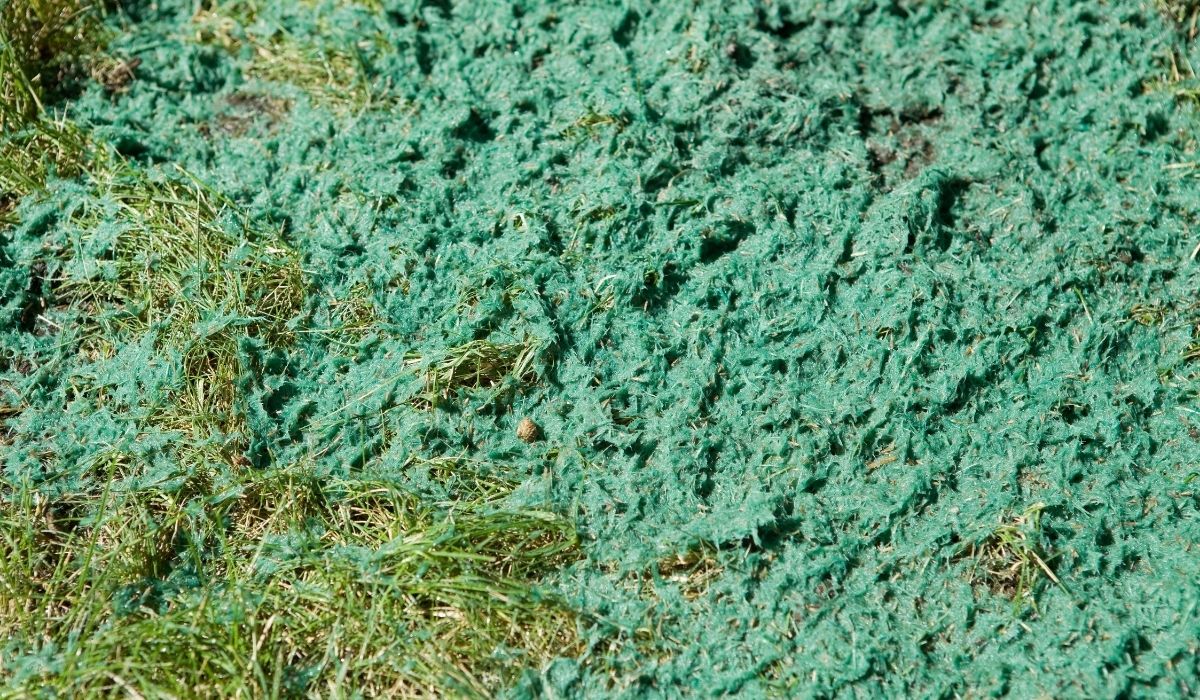Last Updated on August 16, 2022 by Griselda M.
In this post, you will find out how long can hydroseed go without water.
Hydroseeding is a technology that is becoming more and more popular for rapidly establishing grass and turf on steeper slopes and places where traditional sod planting is not possible. But first, let’s have a look at the limitations of this technology, in terms of its water requirements after seeding.
What is Hydroseeding?
Hydroseeding refers to a technology where a slurry of grass (and sometimes other plant seeds) and fertilizer, bulking agents such as straw/coir/paper pulp, and then things that make the mixture sticky, tackifiers, and sometimes lime and other soil amendments are sprayed on the soil surface. The mixture is designed to rapidly cause grass seeds to germinate, and also to hold moisture and nutrients on the surface while covering the soil and reducing the risk of erosion.
I spoke to a chap that does hydroseeding in my area recently. They mainly do this to cover road-building scars on landscapes, and it was quite interesting how in-depth the process is. He goes to a site that needs hydroseeding and takes soil samples. These samples are sent to a laboratory for pH and nutrient analysis, and then he integrates the analyses and mixes his hydroseed mix accordingly to get the pH of the mix appropriate for the different surfaces. The area they work on has very varied soil types, hence what works for one soil will fail for another.
How Long Can Hydroseed Go Without Water? Will It Grow Without Watering?
Under optimal conditions, hydroseed tends to germinate in 5 to 10 days. In harsher situations, it can take about 14 to 15 days.
Typically it is useful to try and time your hydroseeding to coincide with a drizzly, but not torrential rainy time of year. Hydroseeding in the peak heat of summer is not a good idea. Typically in my area, people aim for early spring, and in the absence of natural rain, will provide about an inch of rainfall equivalent every 10 days, or as needed if the weather is a bit drier.
If you hydroseed land, and then have a hot dry spell, it is essential to water the hydroseed – it will die under these conditions. This then gives you an expensive layer of designer stubble on your land that you will have to hydroseed again at great cost.

How To Prepare The Area To Be Hydro-seeded?
Typically it is a good idea to remove weeds and plants from the area to be hydro-seeded. Normally hydroseeding is performed by spraying the slurry onto the soil to achieve a uniform cover. In the places I have seen folks doing this there are often rocks and old tree stumps that are present – the operators spray around these but the rocks can “cast a shadow” behind them. If you can remove rocks your cover will be better.
I am not a big fan of herbicides, but the one operator I know tends to arrive two weeks before his hydroseeding campaign and sprays the area with glyphosate (Roundup). This kills weeds and other problems. He also takes the soil samples. Two weeks later, armed with the soil data and correct hydroseed mixes he then sprays the mixture and the results he achieves are very impressive.
How To Maintain Your Hydro-Seeded Lawn?
To keep your Hydro seeded lawn green and healthy, you need to fertilize it, water it, and weed control it.
Once a hydro-seeded lawn is established it follows normal lawn maintenance rules to keep it going. Water regularly, but not excessively.
You should also apply fertilizer to the soil every two to three weeks during the growing season. Typically in the past, people used straight chemical fertilizers. These typically have names such as 3:2:3 and 3:1:5 etc.
This denotes the ratios of Nitrogen, Phosphate, and Potassium in the fertilizer. Plants actually need a lot more than just these nutrients so I find that the interest is shifting now towards natural fertilizers that provide nutrients but also build the soil in your lawn.
These contain various natural waste products, such as milled chicken feathers, that provide slow-release nitrogen. These organic components also add to the structure of the soil improving water retention and improving the health and disease resistance properties of your lawn.
A natural lawn is quite a good thing – children play on lawns and have thin skins that allow pesticides and herbicides into their blood. As much as the big chemical companies will tell you their products are “safe like water” there is a perfectly natural reason the bottles have a skull hazard mark on them – they are toxic. The fewer poisons we have to put in our environment around us, the healthier we will be in the long run.
Healthy plants win their own battles against pests – unhealthy plants need poisons to help them win. Hence I always err on the side of caution to keep my plants as healthy as possible.
Best Time To Plant Hydroseed
Hydroseed provides excellent erosion control and holds moisture in the soil. The best time to plant it is in early spring, as soon as the ground has thawed and when the soil is still moist.
Does hydroseed need to be exposed to direct sunlight?
Yes. To grow grass needs light. So naturally, it will need sunlight – again, a very hot summer day is going to probably just burn your seedlings, hence timing is important. Spring or a cooler period of the year is the best time to hydroseed.
You can use different tools and methods to shade your lawn from the sun. One way is to mulch. Mulching is a great option because it keeps water on top of the soil. It also helps keep weeds at bay. If your lawn is small, you can mulch with leaves or grass clippings. On larger lawns, you can mulch with hay, wood chips, or straw.
Final Words
There is no general rule – the product is designed to retain moisture, but there is only so long this can work! Factors such as wind speed, humidity, and temperature affect the rate at which your hydro-seeded area will dry out. Supplemental irrigation will help ensure success.
As a rule of thumb, I would suggest if there is no rain, you probably need to water every three to five days after seeding to keep the system moist and effective. Naturally do not water with jets of water – a fine mist is needed.
FAQ
How often does hydroseed need to be watered?
If the hydroseed mixture starts to get a bit dry, you need to water it. Once the hydroseeded lawn is established it is actually now just a lawn - water it as you would any lawn. If you get worried, buy a simple soil moisture probe and measure the soil moisture. These probes cost about $20 on Amazon.
Will rain wash away hydroseed?
This will depend on the mix the applicator used. Generally, for steep slopes they tend to use quite sticky mixtures that are pretty resistant to erosion. This does not mean that an extreme flood will not wash them away, but just that under normal rainfall conditions the mixture will probably stay around long enough for the grass to germinate and for the roots to bind things together.
Why is my hydroseed not growing?
If the applicator got the soil pH wrong and mixed your mix with too much or too little lime the seeds may germinate but then struggle. Sometimes a blast of warm air on an unexpected warm day can also burn the freshly germinated grass seedlings.
Read more about Self Watering Planter Benefits
Branko is the world‘s most enthusiastic gardener! He is always on the hunt for the perfect flower, bush or tree to add to his ever–growing garden. He is known for his love of all things green, and his passion for nurturing the plants he grows is unmatched. He loves to get his hands dirty and can often be found humbly tending to his garden at all hours of the day. Branko is the go–to guy when it comes to gardening advice – he is always happy to share his knowledge and wisdom with anyone who will listen. He also loves to play pranks on unsuspecting visitors, so beware if you enter his garden!



